Evaporative Fractionation as the Important Formation Mechanism of Light Oil Reservoirs in the Dongying Depression, NE China
Abstract
:1. Introduction
2. Geological Setting
3. Samples and Methods
3.1. Samples
3.2. Methods
3.2.1. Oil Analysis
3.2.2. Light Hydrocarbons Analysis
3.2.3. Gas Analysis
4. Results
4.1. Petroleum Properties
4.1.1. Oil Physical Property and Alkane Characteristics
4.1.2. Characterization of Steranes and Terpanes
4.2. Light Hydrocarbon and Diamondoid Composition
4.3. Natural Gas Molecular Compositions
5. Discussion
5.1. Genesis and Migration Fractionation of Natural Gas
5.2. Evaporative Fractionation on the Oil
5.3. Evaporative Fractionation on the Oil
5.3.1. Effect of Evaporative Fractionation on the Diamondoid Concentrations
5.3.2. Effect of Evaporative Fractionation on the Diamondoid Ratios
5.4. Genesis of Light Petroleum Reservoir in Dongying Depression
6. Conclusions
Author Contributions
Funding
Data Availability Statement
Conflicts of Interest
References
- Nissenbaum, A.; Goldberg, M.; Aizenshtat, Z. Immature condensate from southeastern Mediterranean coastal plain, Israel. AAPG Bull. 1985, 69, 46–949. [Google Scholar]
- Thompson, K.F.M. Fractionated aromatic petroleums and the generation of gas-condensates. Org. Geochem. 1987, 11, 573–590. [Google Scholar] [CrossRef]
- Wever, H.E. Petroleum and Source Rock Characterization Based on C7 Star Plot Results: Examples from Egypt. AAPG Bull. 2000, 84, 1041–1054. [Google Scholar]
- Isaksen, G.H. Central North Sea hydrocarbon systems: Generation, migration, entrapment, and thermal degradation of oil and gas. AAPG Bull. 2004, 88, 1545–1572. [Google Scholar] [CrossRef]
- Saller, A.; Lin, R.; Dunham, J. Leaves in turbidite sands: The main source of oil and gas in the deep-water Kutei Basin, Indonesia. AAPG Bull. 2006, 90, 1585–1608. [Google Scholar] [CrossRef]
- Wang, Q.; Hao, F.; Niu, C.; Zou, H.; Miao, Q.; Yin, J.; Cao, Y.; Liu, M. Origins and deep petroleum dynamic accumulation in the southwest part of the Bozhong depression, Bohai Bay Basin: Insights from geochemical and geological evidences. Mar. Pet. Geol. 2021, 134, 105347. [Google Scholar] [CrossRef]
- Dow, W.G. Kerogen studies and geological interpretations. J. Geochem. Explor. 1977, 7, 79–99. [Google Scholar] [CrossRef]
- Tissot, B.P.; Welte, D.H. Petroleum Formation and Occurrence, 2nd ed.; Springer: Berlin/Heidelberg, Germany; New York, NY, USA, 1984. [Google Scholar]
- Snowdon, L.R.; Powell, T.G. Immature Oil and Condensate—Modification of Hydrocarbon Generation Model for Terrestrial Organic Matter. AAPG Bull. 1982, 66, 775–788. [Google Scholar]
- Connan, J.; Cassou, A.M. Properties of gases and petroleum liquids derived from terrestrial kerogen at various maturation levels. Geochim. Cosmochim. Acta 1980, 44, 1–23. [Google Scholar] [CrossRef]
- Horsfield, B.; Schenk, H.J.; Mills, N.; Welte, D.H. An investigation of the in-reservoir conversion of oil to gas: Compositional and kinetic findings from closed-system programmed-temperature pyrolysis. Org. Geochem. 1992, 19, 191–204. [Google Scholar] [CrossRef]
- Hill, R.J.; Tang, Y.; Kaplan, I.R. Insights into oil cracking based on laboratory experiments. Org. Geochem. 2003, 34, 1651–1672. [Google Scholar] [CrossRef]
- Hossain, M.A.; Suzuki, N.; Matsumoto, K.; Sakamoto, R.; Takeda, N. In-reservoir fractionation and the accumulation of oil and condensates in the Surma Basin, Ne Bangladesh. J. Pet. Geol. 2014, 37, 269–286. [Google Scholar] [CrossRef]
- Thompson, K.F.M. Gas-condensate migration and oil fractionation in deltaic systems. Mar. Pet. Geol. 1988, 5, 237–246. [Google Scholar] [CrossRef]
- Thompson, K.F.M. Aspects of petroleum basin evolution due to gas advection and evaporative fractionation. Org. Geochem. 2010, 41, 370–385. [Google Scholar] [CrossRef]
- Kotarba, M.J.; Bilkiewicz, E.; Więcław, D.; Radkovets, N.Y.; Koltun, Y.V.; Kowalski, A.; Kmiecik, N.; Romanowski, T. Origin and migration of oil and natural gas in the central part of the Ukrainian outer Carpathians: Geochemical and geological approach. AAPG Bull. 2020, 104, 1323–1356. [Google Scholar] [CrossRef]
- Zhu, X.; Chen, J.; Zhang, C.; Wang, Y.; Liu, K.; Zhang, T. Effects of evaporative fractionation on diamondoid hydrocarbons in condensates from the Xihu Sag, East China Sea Shelf Basin. Mar. Pet. Geol. 2021, 126, 104929. [Google Scholar] [CrossRef]
- Yu, Q.; Sun, P.; Cai, C.; Wang, D.; Peng, Y. Phase fractionation controlling regional distribution of diamondoids: A case study from the Halahatang oil field, Tarim Basin, China. Mar. Pet. Geol. 2022, 140, 105674. [Google Scholar]
- Zhang, Z.; Zhang, Y.; Zhu, G.; Han, J.; Cai, L. Variations of diamondoids distributions in petroleum fluids during migration induced phase fractionation: A case study from the Tazhong area, NW China. J. Pet. Sci. Eng. 2019, 179, 1012–1022. [Google Scholar] [CrossRef]
- Mehay, S.; Hashem, M.; Rouis, L.; Mollianiyazov, E.; Bennett, B.; Stankiewicz, A. Understanding lateral and vertical fluid variations in the Pliocene sandstone reservoirs in the eastern South Caspian Basin. AAPG Bull. 2021, 105, 2181–2205. [Google Scholar] [CrossRef]
- Huang, W.; Yu, S.; Zhang, H.; Xiao, Z.; Liu, D. Diamondoid fractionation and implications for the Kekeya condensate field in the Southwestern Depression of the Tarim Basin, NW China. Mar. Pet. Geol. 2022, 138, 105551. [Google Scholar] [CrossRef]
- Meulbroek, P.; Cathles, L.; Whelan, J. Phase fractionation at South Eugene Island Block 330. Org. Geochem. 1998, 29, 223–239. [Google Scholar] [CrossRef]
- Losh, S.; Walter, L.; Meulbroek, P.; Martini, A.; Cathles, L.; Whelan, J. Reservoir Fluids and Their Migration into the South Eugene Island Block 330 Reservoirs, Offshore Louisiana. AAPG Bull. 2002, 86, 1463–1488. [Google Scholar]
- Ulmishek, G.; Harrison, W. Oil and Gas Developments in USSR in 1982. AAPG Bull. 1983, 67, 1717–1722. [Google Scholar]
- Dzou, L.I.P. Kuparuk oil field, Alaska, a mixture of Kekiktuk gas condensate and Shublik oil. AAPG Bull. 2010, 94, 1761–1778. [Google Scholar] [CrossRef]
- Isaksen, G.H.; Patience, R.; Graas, G.V.; Jenssen, A.I. Hydrocarbon System Analysis in a Rift Basin with Mixed Marine and Nonmarine Source Rocks: The South Viking Graben, North Sea. AAPG Bull. 2004, 86, 557–591. [Google Scholar]
- Lerch, B.; Karlsen, D.A.; Abay, T.B.; Duggan, D.; Reinert Seland, R.; Backer-Owe, K. Regional petroleum alteration trends in Barents Sea oils and condensates as a clue to migration regimes and processes. AAPG Bull. 2016, 100, 165–190. [Google Scholar] [CrossRef]
- Jiang, W.; Li, Y.; Xiong, Y. Reservoir alteration of crude oils in the Junggar Basin, northwest China: Insights from diamondoid indices-ScienceDirect. Mar. Pet. Geol. 2020, 119, 104451. [Google Scholar] [CrossRef]
- Su, A.; Chen, H.; Zhao, J.; Zhang, T.; Feng, Y.; Wang, C. Natural gas washing induces condensate formation from coal measures in the Pinghu Slope Belt of the Xihu Depression, East China Sea Basin: Insights from fluid inclusion, geochemistry, and rock gold-tube pyrolysis. Mar. Pet. Geol. 2020, 118, 104450. [Google Scholar] [CrossRef]
- Gussow, W.C. Differential Entrapment of Oil and Gas: A Fundamental Principle. AAPG Bull. 1954, 38, 816–853. [Google Scholar]
- Silverman, S.R. Migration and Segregation of Oil and Gas. AAPG Bull. 1965, 49, 1766. [Google Scholar] [CrossRef]
- Larter, S.; Mills, N. Phase-controlled molecular fractionations in migrating petroleum charges. Geol. Soc. Lond. 1991, 59, 137–147. [Google Scholar] [CrossRef]
- Dzou, L.I.P.; Hughes, W.B. Geochemistry of oils and condensates K Field offshore Taiwan: A case study in migration fractionation. Org. Geochem. 1993, 20, 437–462. [Google Scholar] [CrossRef]
- Curiale, J.A.; Bromley, B.W. Migration induced compositional changes in oils and condensates of a single field. Org. Geochem. 1996, 24, 1097–1113. [Google Scholar] [CrossRef]
- Qiao, R.; Chen, Z.; Li, C.; Wang, D.; Gao, Y.; Zhao, L.; Li, U.; Liu, J. Geochemistry and accumulation of petroleum in deep lacustrine reservoirs: A case study of Dongying Depression, Bohai Bay Basin. J. Pet. Sci. Eng. 2022, 213, 110433. [Google Scholar] [CrossRef]
- Chen, Z.; Qiao, R.; Li, C.; Wang, D.; Gao, Y. Hydrocarbon generation potential and model of the deep lacustrine source rocks in the Dongying Depression, Bohai Bay Basin. Mar. Pet. Geol. 2022, 140, 105656. [Google Scholar] [CrossRef]
- Ping, H.; Chen, H.; Jia, G. Petroleum accumulation in the deeply buried reservoirs in the northern Dongying Depression, Bohai Bay Basin, China: New insights from fluid inclusions, natural gas geochemistry, and 1-D basin modeling. Mar. Pet. Geol. 2017, 80, 70–93. [Google Scholar] [CrossRef]
- Ping, H.; Chen, H.; Thiéry, R.; George, S.C. Effects of oil cracking on fluorescence color, homogenization temperature and trapping pressure reconstruction of oil inclusions from deeply buried reservoirs in the northern Dongying Depression, Bohai Bay Basin, China. Mar. Pet. Geol. 2017, 80, 538–562. [Google Scholar] [CrossRef]
- Qiao, R.; Chen, Z. Petroleum phase evolution at high temperature: A combined study of oil cracking experiment and deep oil in Dongying Depression, eastern China. Fuel 2022, 326, 124978. [Google Scholar] [CrossRef]
- Peters, K.E.; Moldowan, J.M.; McCaffrey, M.A.; Fago, F.J. Selective biodegradation of extended hopanes to 25-NHs in petroleum reservoirs. Insights from molecular mechanics. Org. Geochem. 1996, 24, 765–783. [Google Scholar] [CrossRef]
- Peters, K.E.; Walters, C.C.; Moldowan, J.M. The Biomarker Guide, 2nd ed.; Cambridge University Press: New York, NY, USA, 2005. [Google Scholar]
- Bennett, B.; Fustic, M.; Farrimond, P.; Huang, H.; Larter, S.R. 25-NHs: Formation during biodegradation of petroleum in the subsurface. Org. Geochem. 2006, 37, 787–797. [Google Scholar] [CrossRef]
- Volkman, J.K. A review of sterol markers for marine and terrigenous organic matter. Org. Geochem. 1986, 9, 83–99. [Google Scholar] [CrossRef]
- Hunt, J.M. Generation and migration of light hydrocarbons. Science 1984, 226, 1265–1270. [Google Scholar] [CrossRef] [PubMed]
- Hunt, J.M.; Huc, A.Y.; Whelan, J.K. Generation of light hydrocarbons in sedimentary rocks. Nature 1980, 288, 688–690. [Google Scholar] [CrossRef]
- Mango, F.D. An invariance in the isoheptanes of petroleum. Science 1987, 237, 514–517. [Google Scholar] [CrossRef] [PubMed]
- Mango, F.D. The origin of light hydrocarbons in petroleum: A kinetic test of the steady-state catalytic hypothesis. Geochim. Cosmochim. Acta 1990, 54, 1315–1323. [Google Scholar] [CrossRef]
- Whiticar, M.J. Carbon and hydrogen isotope systematics of bacterial formation and oxidation of methane. Chem. Geol. 1999, 161, 291–314. [Google Scholar] [CrossRef]
- Prinzhofer, A.; Girard, J.P.; Buschaert, S.; Huiban, Y.; Noirez, S. Chemical and isotopic characterization of hydrocarbon gas traces in porewater of very low permeability rocks: The example of the Callovo-Oxfordian argillites of the eastern part of the Paris Basin. Chem. Geol. 2009, 260, 269–277. [Google Scholar] [CrossRef]
- Pallasser, R.J. Recognising biodegradation in gas/oil accumulations through the d13C compositions of gas components. Org. Geochem. 2000, 31, 1363–1373. [Google Scholar] [CrossRef]
- Rice, D.D.; Claypool, G.E. Generation, accumulation, and resource potential of microbial gas. AAPG Bull. 1981, 65, 5–25. [Google Scholar]
- Schoell, M. Genetic characterization of natural gas. AAPG Bull. 1983, 67, 2225–2238. [Google Scholar]
- Li, J.; Li, Z.; Wang, X.; Wang, D.; Xie, Z. New indexes and charts for genesis identification of multiple natural gases. Pet. Explor. Dev. 2017, 44, 535–543. [Google Scholar] [CrossRef]
- Lorant, F.; Prinzhofer, A.; Behar, F.; Huc, A.Y. Carbon isotopic and molecular constraints on the formation and the expulsion of thermogenic hydrocarbon gases. Chem. Geol. 1998, 147, 249–264. [Google Scholar] [CrossRef]
- Galimov, E.M. Sources and mechanisms of formation of gaseous hydrocarbons in sedimentary rocks. Chem. Geol. 1998, 71, 77–95. [Google Scholar] [CrossRef]
- Xia, X.; Tang, Y. Isotope fractionation of methane during natural gas flow with coupled diffusion and adsorption/desorption. Geochim. Cosmochim. Acta 2012, 77, 489–503. [Google Scholar] [CrossRef]
- Prinzhofer, A.; Mello, M.R.; Freitas, L.C.; Takaki, T. New geochemical characterization of natural gas and its use in oil and gas evaluation. In Petroleum Systems of South Atlantic Margins; Mello, M.R., Katz, B.J., Eds.; AAPG Memoir: Tulsa, OK, USA, 2000; Volume 73, pp. 107–119. [Google Scholar]
- Chung, H.; Gormly, J.R.; Squires, R.M. Origin of gaseous hydrocarbons in subsurface environments: Theoretical considerations of carbon isotope distribution. Chem. Geol. 1988, 71, 91–103. [Google Scholar] [CrossRef]
- Galimov, E.M. Isotope organic geochemistry. Org. Geochem. 2006, 37, 1200–1262. [Google Scholar] [CrossRef]
- Kissin, Y.V. Catagenesis and composition of petroleum: Origin of n-alkanes and isoalkanes in petroleum crudes. Geochim. Et Cosmochim. Acta 1987, 51, 2445–2457. [Google Scholar] [CrossRef]
- Chen, J.; Fu, J.; Sheng, G.; Liu, D.; Zhang, J. Diamondoid hydrocarbon ratios: Novel maturity indices for highly mature crude oils. Org. Geochem. 1996, 25, 179–190. [Google Scholar] [CrossRef]
- Schulz, L.K.; Wilhelms, A.; Rein, E.; Steen, A.S. Application of diamondoids to distinguish source rock facies. Org. Geochem. 2001, 32, 365–375. [Google Scholar] [CrossRef]
- Dahl, J.E.; Moldowan, J.M.; Peters, K.E.; Claypool, G.E.; Rooney, M.A.; Michael, G.E.; Mello, M.R.; Kohnen, M.L. Diamondoid hydrocarbons as indicators of natural oil cracking. Nature 1999, 399, 54–57. [Google Scholar] [CrossRef]
- Gordaze, G.N. Geochemistry of cage hydrocarbon. Pet. Chem. 2008, 48, 241–253. [Google Scholar] [CrossRef]
- Moldowan, J.M.; Dahl, J.; Zinniker, D.; Barbanti, S.M. Underutilized advanced geochemical technologies for oil and gas exploration and production-1. The diamondoids. J. Pet. Sci. Eng. 2015, 126, 87–96. [Google Scholar] [CrossRef]
- Li, Y.; Xiong, Y.; Liang, Q.; Fang, C.; Chen, Y.; Wang, X.; Liao, Z.; Peng, P. The application of diamondoid indices in the Tarim oils. AAPG Bull. 2018, 102, 267–291. [Google Scholar] [CrossRef]
- Li, Y.; Xiong, Y.; Chen, Y.; Tang, Y. The effect of evaporation on the concentration and distribution of diamondoids in oils. Org. Geochem. 2014, 69, 88–97. [Google Scholar] [CrossRef]
- Chen, Z.; Liu, X.; Jin, H.; Wang, Z.; Zhang, L. Study on maturity and type of condensate in Jiyang depression by using diamantane index. Acta Sedimentol. Sin. 2008, 26, 705–708, (In Chinese with English abstract). [Google Scholar]
- Li, J.; Philp, R.P.; Cui, M. Methyl Diamantane Index (MDI) as a Maturity Parameter for Lower Palaeozoic Carbonate Rocks at High Maturity and Overmaturity. Org. Geochem. 2000, 31, 267–272. [Google Scholar]
- Guo, X.; He, S.; Chen, H. Discussion and Application of the Maturity Indicators of Methyl Double Diamantane Hydrocarbons. Bull. Geol. Sci. Technol. 2007, 1, 71–76, (In Chinese with English Abstract). [Google Scholar]

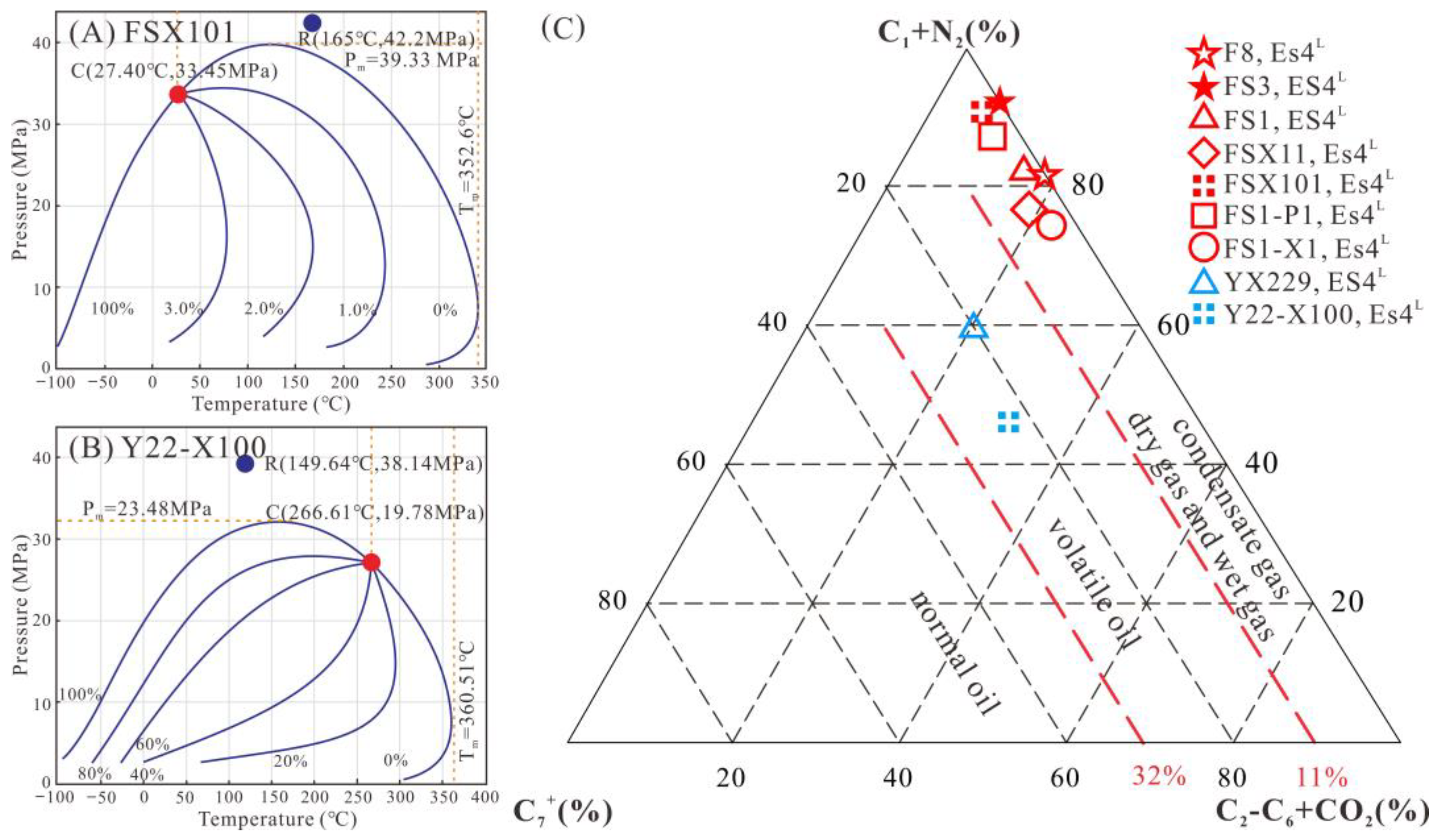
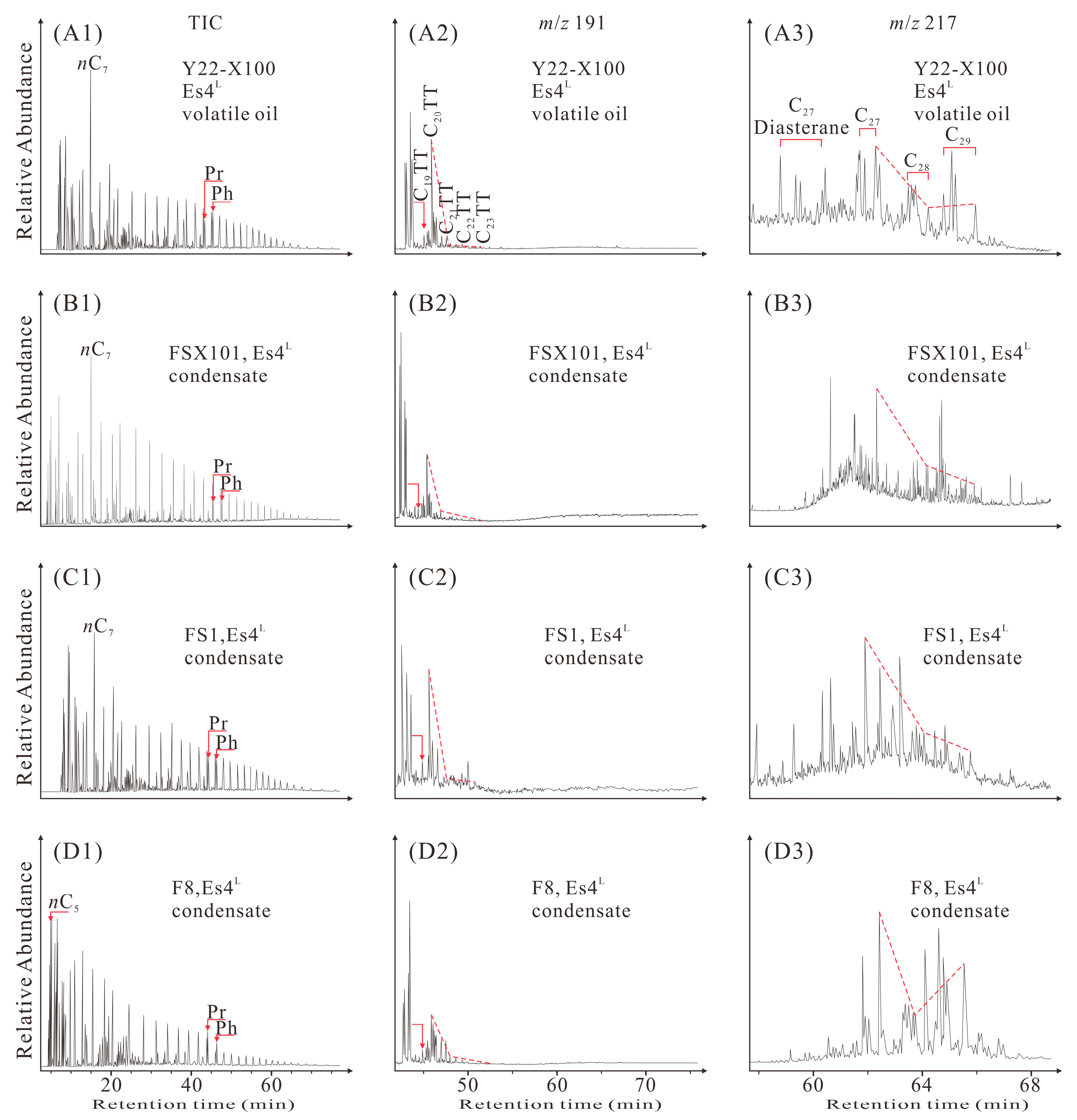
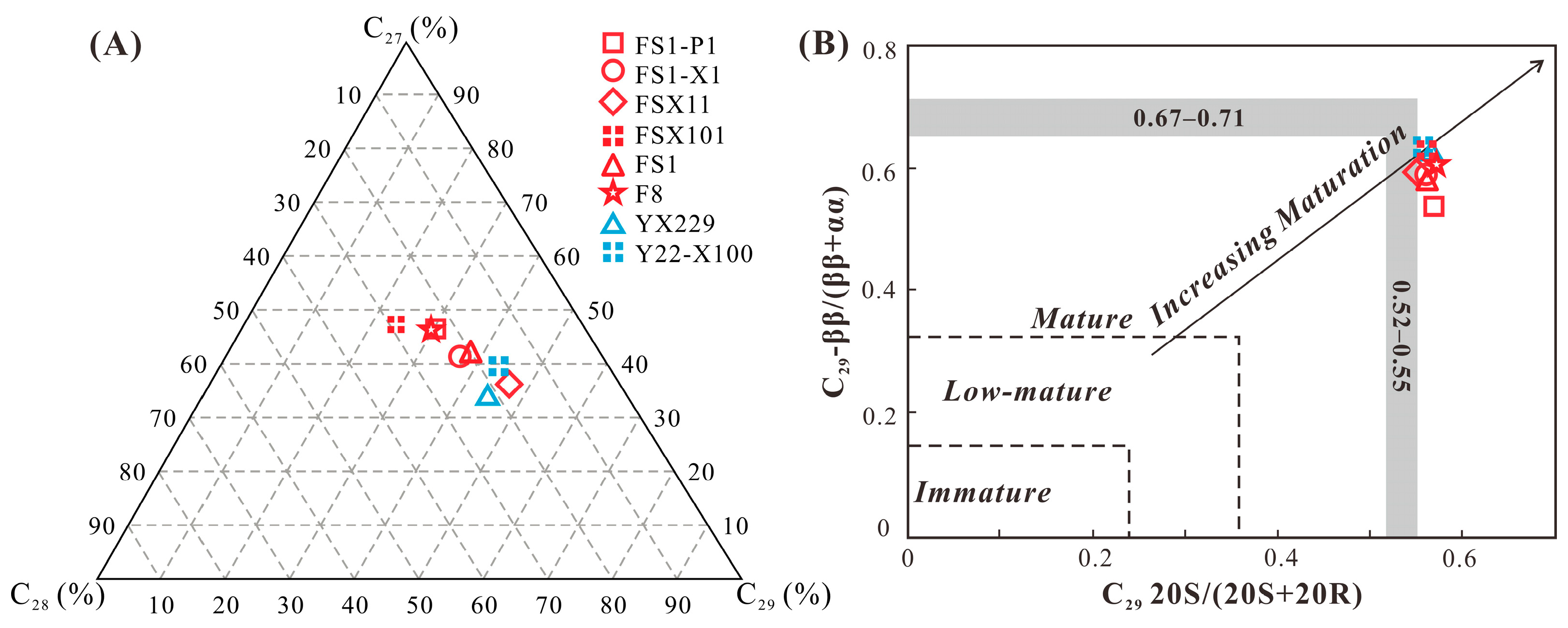
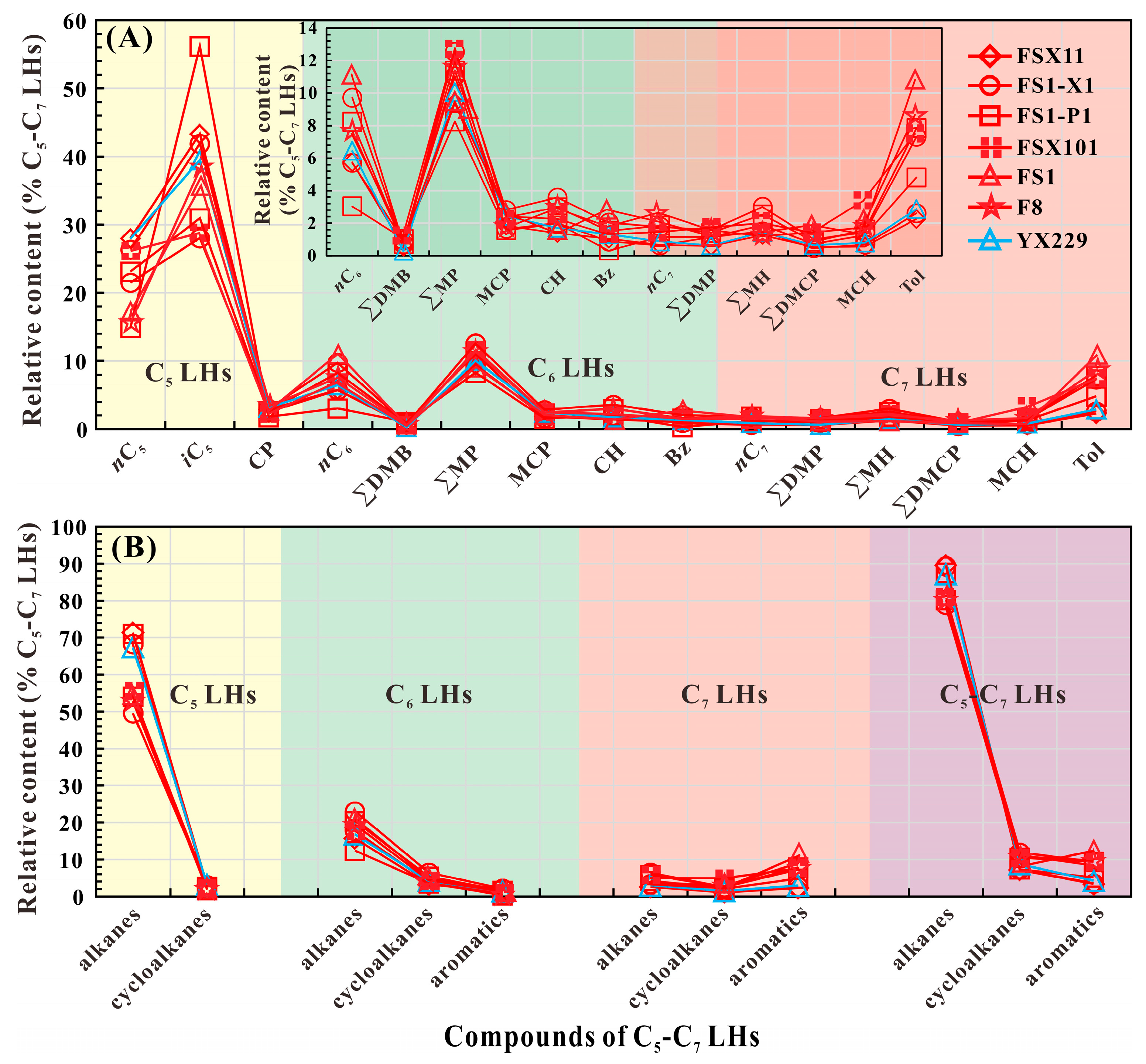
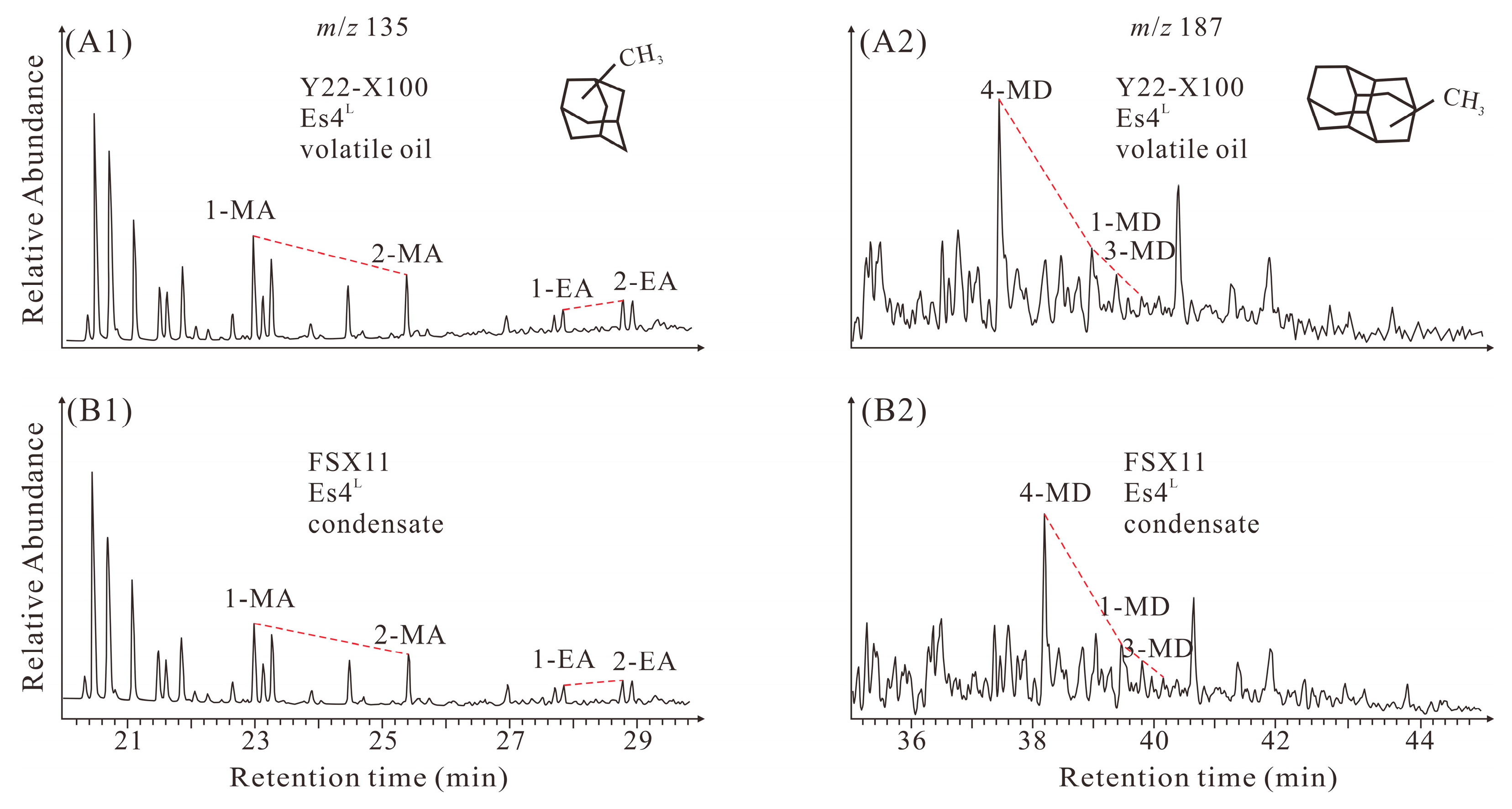
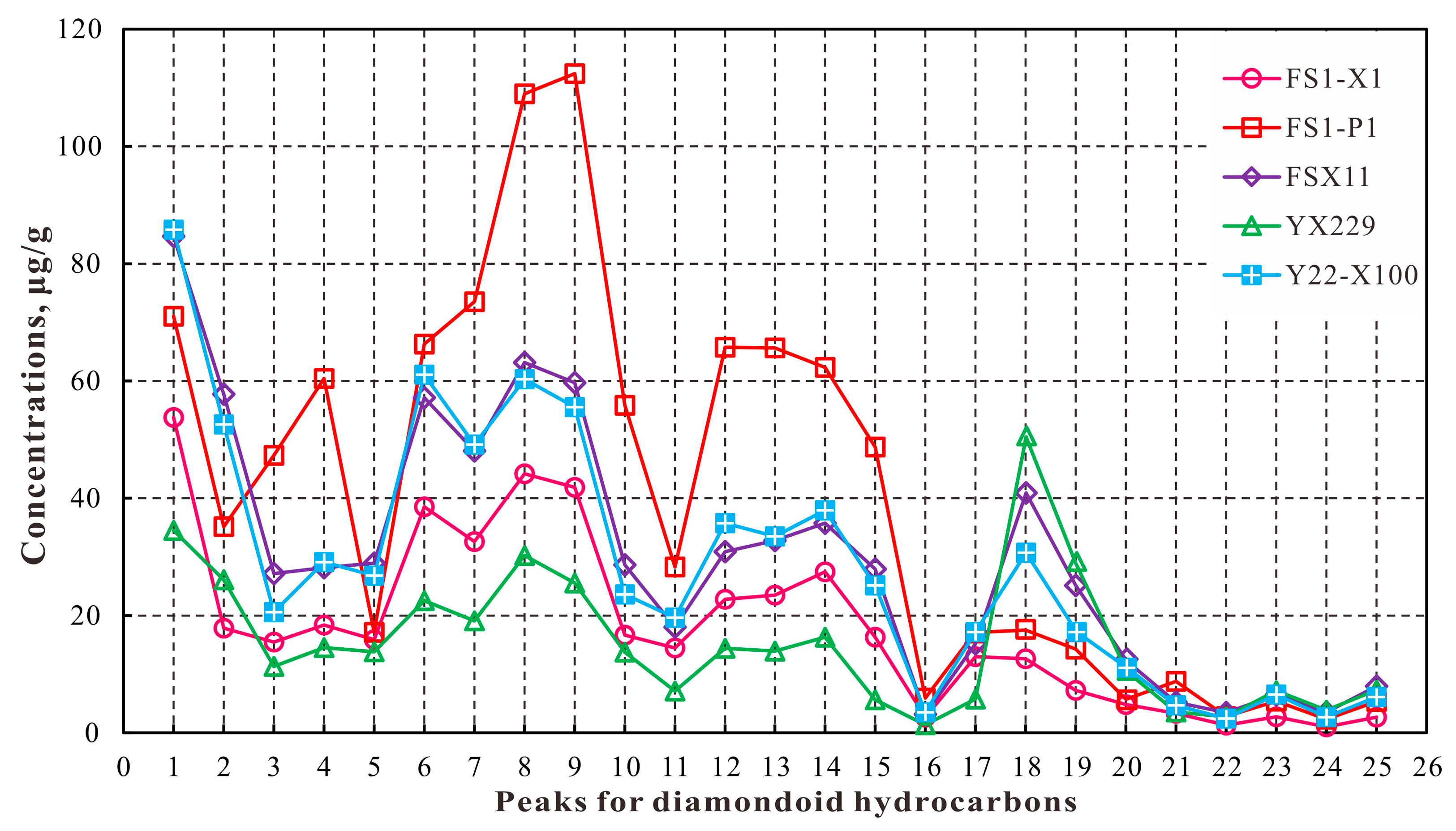


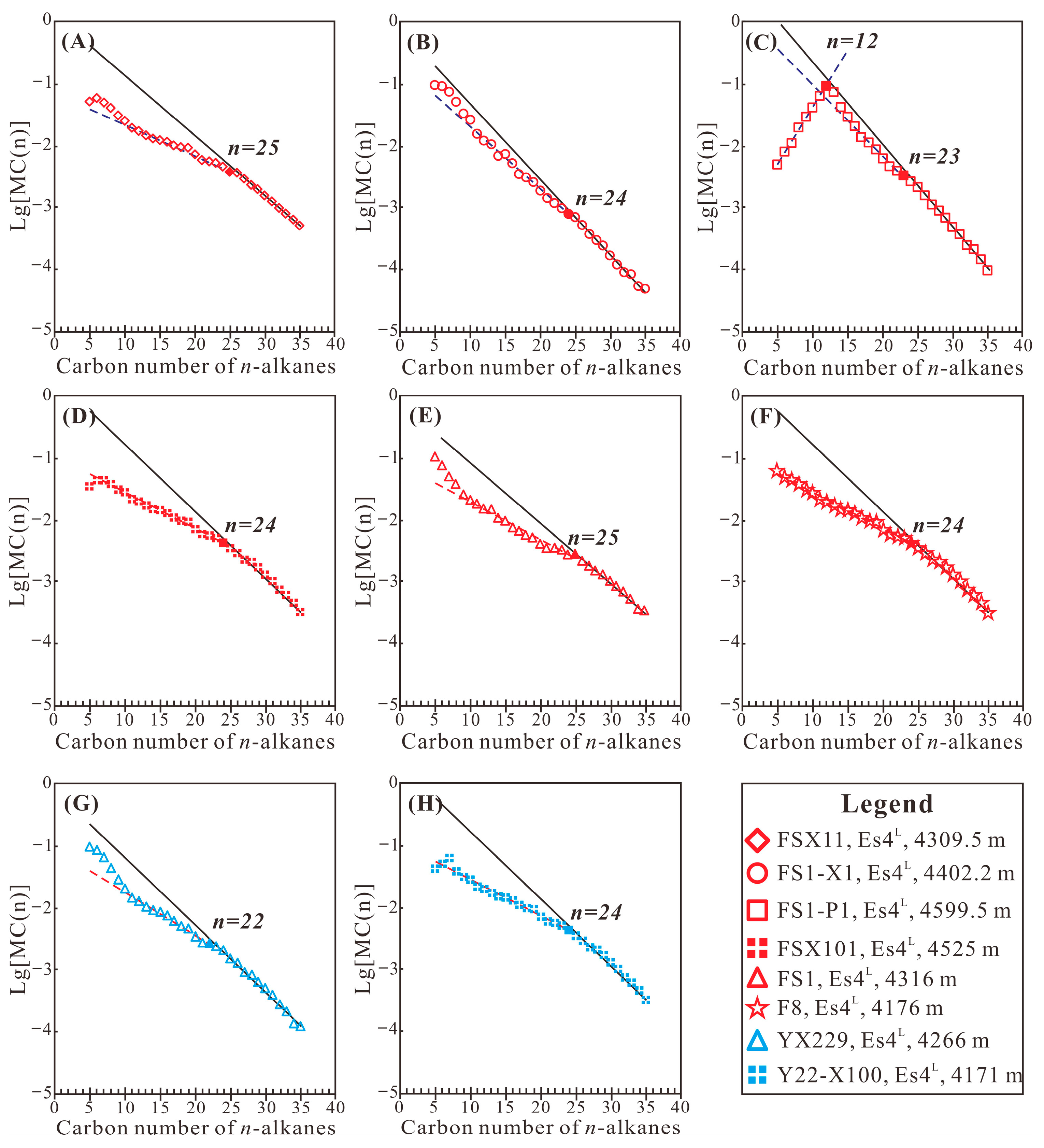
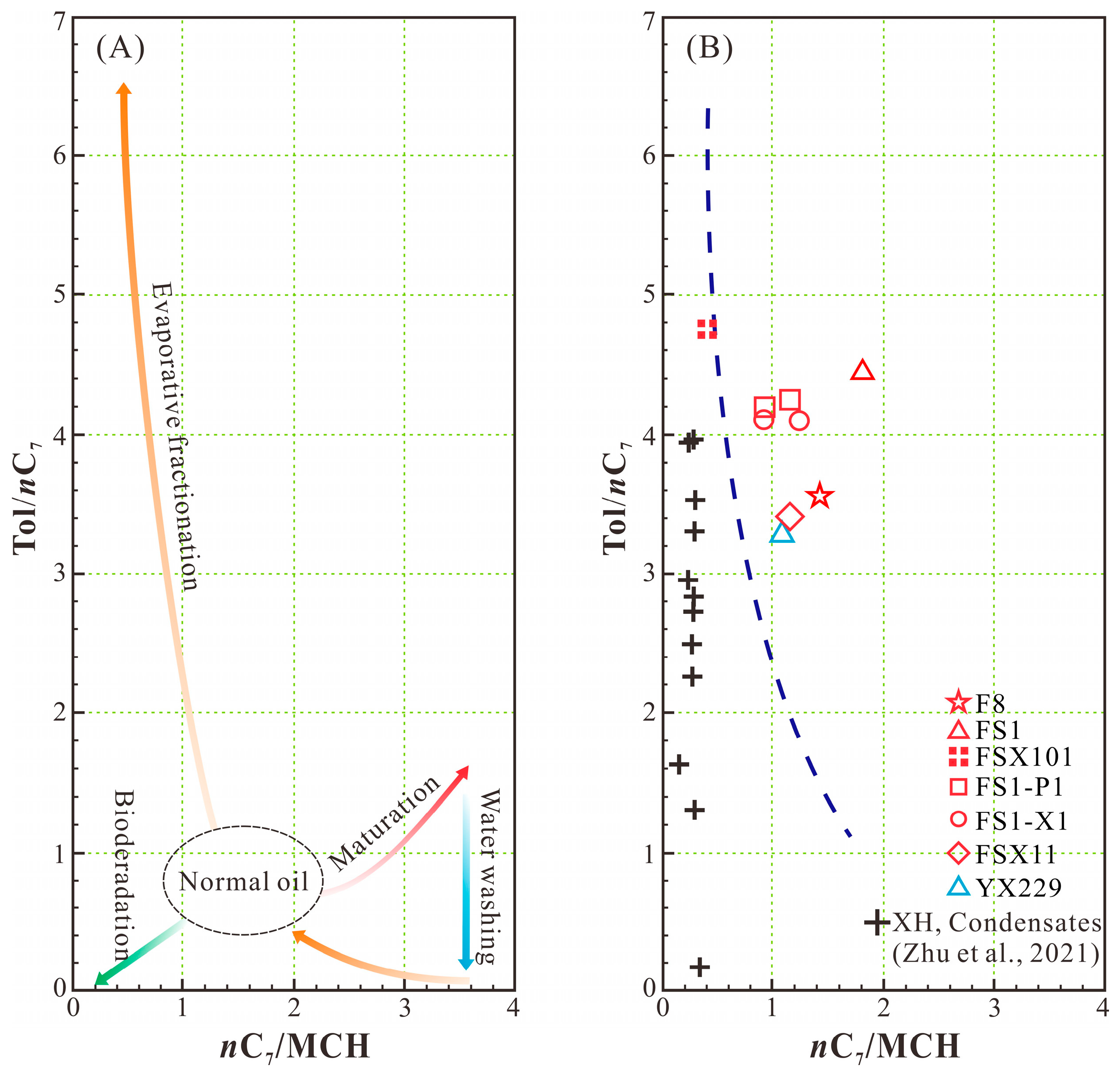
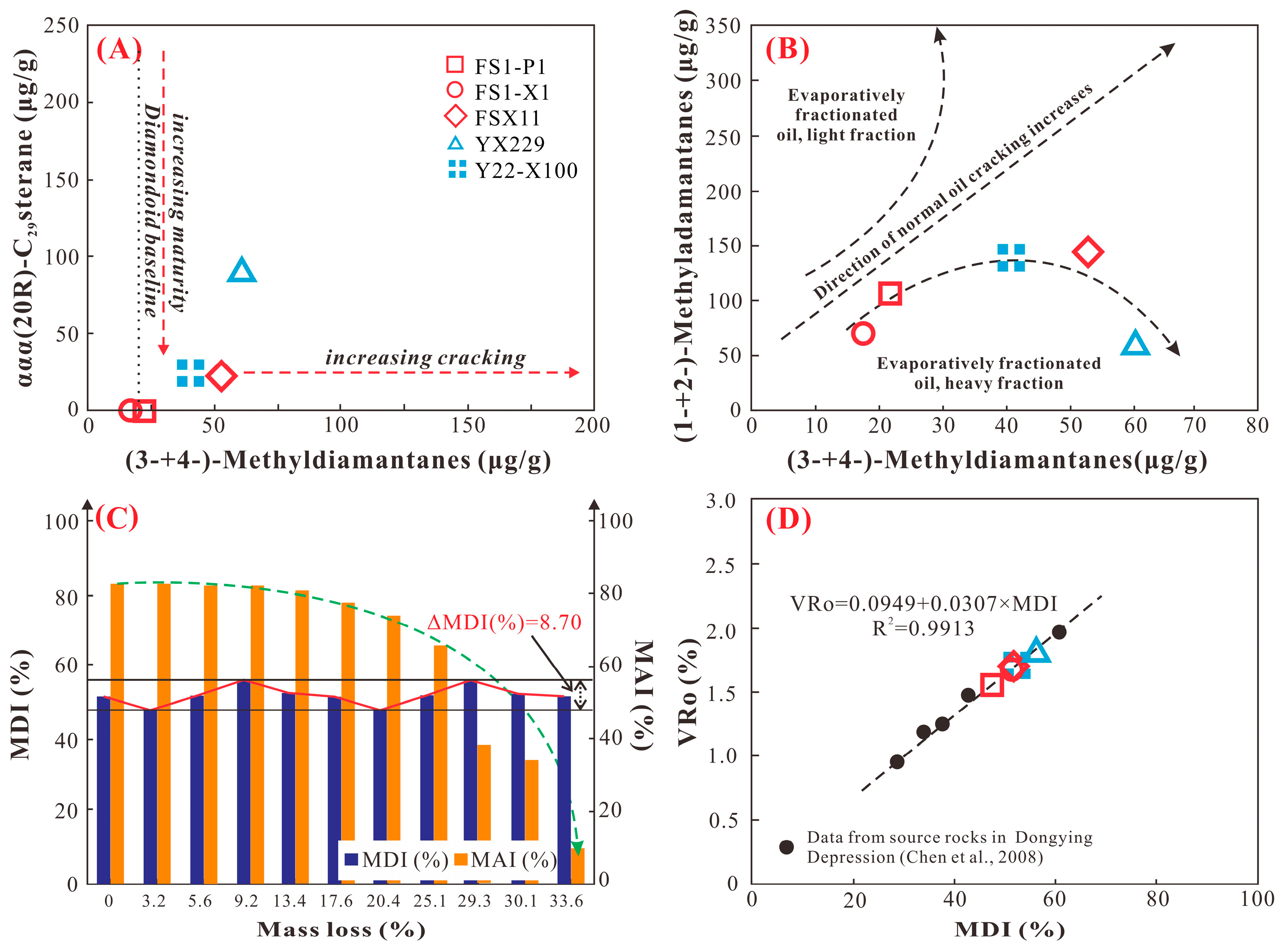

| Well | Strate | Depth (m) | Density, 20 °C, (g/cm3) | Viscosity, 50 °C, (MPa·s) | Sulfur, (%) | Sat, % | Aro, % | Res, % | Asp, % | Reservoir Type * |
|---|---|---|---|---|---|---|---|---|---|---|
| F8 | Es4L | 4176–4191 | 0.72 | 0.82 | 0.55 | 87.4 | 6.75 | 4.14 | 1.71 | COR |
| FS1 | Es4L | 4316–4343 | 0.78 | 0.88 | 0.02 | 78.41 | 9.45 | 5.21 | 6.93 | COR |
| FS1-X1 | Es4L | 4402–4419 | 0.77 | 0.81 | 0.09 | 71.29 | 11.88 | 8.91 | 7.92 | COR |
| FS1-P1 | Es4L | 4599–4770 | 0.82 | 12.80 | nd | 84.00 | 8.00 | 4.80 | 3.20 | COR |
| FSX11 | Es4L | 4309–4467 | 0.77 | nd | nd | 74.83 | 19.05 | 5.44 | 0.68 | COR |
| FSX101 | Es4L | 4525–4552 | 0.79 | 1.80 | 0.03 | 82.00 | 8.20 | 6.40 | 3.40 | COR |
| YX229 | Es4L | 4171–4250 | 0.82 | 5.40 | 0.13 | 77.93 | 12.68 | 5.63 | 3.76 | VOR |
| Y22-X100 | Es4L | 4266–4273 | 0.88 | 4.47 | nd | 73.67 | 13.51 | 5.74 | 7.08 | VOR |
| Well | n-C10−/n-C10+ | Relative Content (%) | αααC2920R | C29-ββ/(ββ + αα) | C29-20S/(20S + 20R) | ||
|---|---|---|---|---|---|---|---|
| C27 | C28 | C29 | μg/g | ||||
| F8 | 1.12 | 42.68 | 20.16 | 37.16 | nd | 0.61 | 0.57 |
| FS1 | 0.57 | 46.54 | 24.12 | 29.34 | nd | 0.58 | 0.56 |
| FS1-X1 | 1.01 | 41.68 | 22.14 | 36.18 | 0.00 | 0.59 | 0.56 |
| FS1-P1 | 0.11 | 47.09 | 23.13 | 29.77 | 0.00 | 0.54 | 0.57 |
| FSX11 | 0.64 | 36.56 | 17.09 | 46.35 | 17.91 | 0.60 | 0.55 |
| FSX101 | 0.94 | 47.54 | 29.12 | 23.34 | nd | 0.63 | 0.56 |
| YX229 | 0.59 | 34.65 | 21.54 | 43.80 | 73.86 | 0.63 | 0.57 |
| Y22-X100 | 0.52 | 39.96 | 17.01 | 43.03 | 19.39 | 0.64 | 0.56 |
| Well | nC7 | MCH | Tol | Tol/nC7 | nC7/MCH | nC5–7 | iC5–7 | CyC5–7 |
|---|---|---|---|---|---|---|---|---|
| % | ||||||||
| F8 | 0.24 | 0.16 | 0.84 | 3.55 | 1.46 | 89.52 | 7.18 | 3.30 |
| FS1 | 0.20 | 0.11 | 0.87 | 4.44 | 1.83 | 87.09 | 8.72 | 4.18 |
| FSX101 | 0.13 | 0.32 | 0.64 | 4.75 | 0.42 | 89.21 | 7.31 | 3.49 |
| FSX11 | 0.06 | 0.05 | 0.21 | 3.40 | 1.17 | 89.52 | 3.30 | 7.18 |
| YX229 | 0.10 | 0.09 | 0.31 | 3.29 | 1.09 | 87.09 | 4.18 | 8.72 |
| FS1-X1 | 0.10 | 0.11 | 0.41 | 4.11 | 0.93 | 89.21 | 3.49 | 7.31 |
| FS1-X1 | 0.44 | 0.35 | 1.80 | 4.09 | 1.24 | 78.84 | 9.35 | 11.82 |
| FS1-P1 | 0.01 | 0.01 | 0.05 | 4.18 | 0.92 | 87.55 | 5.13 | 7.32 |
| FS1-P1 | 0.17 | 0.14 | 0.70 | 4.24 | 1.15 | 80.17 | 9.38 | 10.45 |
| No. | Compound | Abbreviation | FS1-X1 | FS1-P1 | FSX11 | YX229 | Y22-X100 |
|---|---|---|---|---|---|---|---|
| 4402–4419 | 4599–4770 | 4309–4467 | 4171–4250 | 4266–4273 | |||
| Es4L | Es4L | Es4L | Es4L | Es4L | |||
| 1 | Adamantane | A | 15.90 | 17.15 | 28.96 | 13.86 | 26.8 |
| 2 | 1-Methyladamantane | 1-MA | 53.76 | 71.05 | 84.68 | 34.54 | 85.77 |
| 3 | 2-Methyladamantane | 2-MA | 17.86 | 35.16 | 57.76 | 26.13 | 52.61 |
| 4 | 1-Ethyladamantane | 1-EA | 15.51 | 47.31 | 27.15 | 11.32 | 20.59 |
| 5 | 2-Ethyladamantane | 2-EA | 18.40 | 60.39 | 28.20 | 14.57 | 29.10 |
| 6 | 1,3-Dimethyladamantane | 1,3-DMA | 38.54 | 66.29 | 57.13 | 22.55 | 61.06 |
| 7 | 1,4-Dimethyladamantane (cis) | 1,4-DMA | 32.64 | 73.50 | 48.10 | 19.09 | 49.15 |
| 8 | 1,4-Dimethyladamantane (trans) | 1,4-DMA | 44.15 | 108.94 | 63.15 | 30.23 | 60.31 |
| 9 | 1,2-Dimethyladamantane | 1,2-DMA | 41.84 | 112.39 | 59.70 | 25.56 | 55.55 |
| 10 | 1-Ethyl-3-methyladamantane | 1 Et,3-MA | 16.66 | 55.83 | 28.64 | 13.80 | 23.60 |
| 11 | 1,3,5Trimethyladamantane | 1,3,5-TMA | 14.48 | 28.32 | 18.03 | 7.13 | 19.67 |
| 12 | 1,3,6-Trimethyladamantane | 1,3,6-TMA | 22.76 | 65.73 | 30.89 | 14.40 | 35.74 |
| 13 | 1,3,4-Trimethyladamantane (cis) | 1,3,4-TMA | 23.47 | 65.63 | 32.81 | 13.93 | 33.53 |
| 14 | 1,3,4-Trimethyladamantane (trans) | 1,3,4-TMA | 27.44 | 62.29 | 35.76 | 16.3 | 37.98 |
| 15 | l-Ethyl-3,5-dimethyladamantane | 1 Et,3,5-DMA | 16.34 | 48.74 | 27.94 | 5.67 | 25.14 |
| 16 | 1,3,5,7-Tetramethyladamantane | 1,3,5,7-TeMA | 2.68 | 5.96 | 3.15 | 1.40 | 3.51 |
| 17 | 1,2,5,7-Tetramethyladamantane | 1,2,5,7-TeMA | 13.03 | 16.20 | 15.22 | 5.78 | 17.20 |
| 18 | Diamantane | D | 3.34 | 8.78 | 5.22 | 3.58 | 4.68 |
| 19 | 4-Methyldiamantane | 4-MD | 12.62 | 17.01 | 40.44 | 50.17 | 30.22 |
| 20 | 1-Methyldiamantane | 1-MD | 7.35 | 13.96 | 24.96 | 28.68 | 16.79 |
| 21 | 3-Methyldiamantane | 3-MD | 4.47 | 4.81 | 12.57 | 10.47 | 10.82 |
| 22 | 4,9-Dimethyldiamantane | 4,9-DMD | 1.33 | 2.81 | 3.46 | 2.75 | 2.46 |
| 23 | 1,2- + 2,4-Dimethyldiamantane | 1,2 + 2,4-DMD | 2.78 | 5.41 | 6.48 | 7.21 | 6.57 |
| 24 | 4,8-Dimethyldiamantane | 4,8-DMD | 1.03 | 2.34 | 3.54 | 3.86 | 2.68 |
| 25 | 3,4-Dimethyldiamantane | 3,4-DMD | 2.69 | 5.35 | 7.99 | 7.30 | 6.13 |
| 26 | Total diamondoid hydrocarbons | 451.07 | 1001.35 | 751.93 | 390.28 | 717.66 |
| Well | GOR, (m3/m3) | DI, (%) | Molecular Composition, mol % | δ13C PDB, ‰ | ||||||||||
|---|---|---|---|---|---|---|---|---|---|---|---|---|---|---|
| C1 | C2 | C3 | C4 | C5 | N2 | CO2 | δ13C1 | δ13C2 | δ13C3 | δ13C4 | δ13C5 | |||
| F8 | 8805 | 82.8 | 81.5 | 7.4 | 4.0 | 4.2 | 1.3 | 1.6 | 0.0 | −49.1 | −32.5 | −28 | nd | nd |
| FS1 | 1448 | 91.7 | 90.7 | 4.6 | 1.7 | 1.5 | 0.4 | 0.0 | 1.1 | −50.4 | −30.8 | −26.8 | nd | nd |
| FS1–P1 | 2937 | 88.4 | 78.6 | 4.6 | 2.5 | 2.0 | 1.3 | 8.6 | 2.4 | −47.4 | −30 | −25.6 | −23.7 | nd |
| FS1–X1 | 2048 | 71.0 | 63.0 | 7.0 | 6.7 | 7.5 | 4.4 | 8.5 | 2.9 | −47.9 | −30.6 | −26.1 | −25.5 | −25.1 |
| FSX11 | 1619 | 77.5 | 67.7 | 7.5 | 5.6 | 4.7 | 1.9 | 9.0 | 3.6 | −48.5 | −31.3 | −27.3 | −27 | −26.6 |
| YX229 | 208 | 75.9 | 69.1 | 8.6 | 6.6 | 4.8 | 2.0 | 3.5 | 5.4 | −50.2 | −32.9 | −29 | −28.3 | −27.2 |
| FSX101 | 2119 | 92.1 | 89.9 | 4.3 | 1.8 | 1.0 | 0.5 | 0.3 | 2.1 | nd | nd | nd | nd | nd |
| FS3 | nd | 95.2 | 92.1 | 3.2 | 0.9 | 0.6 | 0.0 | 0.1 | 3.1 | −44.7 | −30 | −23.4 | nd | nd |
Disclaimer/Publisher’s Note: The statements, opinions and data contained in all publications are solely those of the individual author(s) and contributor(s) and not of MDPI and/or the editor(s). MDPI and/or the editor(s) disclaim responsibility for any injury to people or property resulting from any ideas, methods, instructions or products referred to in the content. |
© 2024 by the authors. Licensee MDPI, Basel, Switzerland. This article is an open access article distributed under the terms and conditions of the Creative Commons Attribution (CC BY) license (https://creativecommons.org/licenses/by/4.0/).
Share and Cite
Qiao, R.; Li, M.; Zhang, D.; Chen, Z.; Xiao, H. Evaporative Fractionation as the Important Formation Mechanism of Light Oil Reservoirs in the Dongying Depression, NE China. Energies 2024, 17, 3734. https://doi.org/10.3390/en17153734
Qiao R, Li M, Zhang D, Chen Z, Xiao H. Evaporative Fractionation as the Important Formation Mechanism of Light Oil Reservoirs in the Dongying Depression, NE China. Energies. 2024; 17(15):3734. https://doi.org/10.3390/en17153734
Chicago/Turabian StyleQiao, Rongzhen, Meijun Li, Donglin Zhang, Zhonghong Chen, and Hong Xiao. 2024. "Evaporative Fractionation as the Important Formation Mechanism of Light Oil Reservoirs in the Dongying Depression, NE China" Energies 17, no. 15: 3734. https://doi.org/10.3390/en17153734





